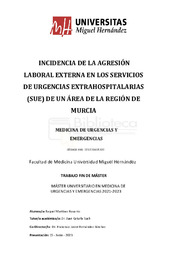Por favor, use este identificador para citar o enlazar este ítem:
https://hdl.handle.net/11000/30193Registro completo de metadatos
| Campo DC | Valor | Lengua/Idioma |
|---|---|---|
| dc.contributor.advisor | Caturla Such, Juan Manuel | - |
| dc.contributor.advisor | Fernández Sánchez, Francisco Javier | - |
| dc.contributor.author | Martínez Navarro, Raquel | - |
| dc.contributor.other | Departamentos de la UMH::Medicina Clínica | es_ES |
| dc.date.accessioned | 2023-11-17T13:38:58Z | - |
| dc.date.available | 2023-11-17T13:38:58Z | - |
| dc.date.created | 2023-06-15 | - |
| dc.identifier.uri | https://hdl.handle.net/11000/30193 | - |
| dc.description.abstract | Introducción: El gran aumento en la incidencia de las agresiones recibidas en los centros y servicios de urgencias de la Región de Murcia en los últimos años origina sentimientos de desgana y rechazo en los profesionales sanitarios, pudiendo afectar tanto a las funciones laborales y competencias como a su salud y bienestar. Este hecho resalta la necesidad de la creación de estudios y evaluaciones cuyo fin sea el de tratar de identificar, señalar y prevenir esta hostilidad percibida en los centros y áreas que componen la Región. Objetivo: Describir la existencia y frecuencia de las manifestaciones violentas u hostiles de agresión ya sea física o no física que sufren los profesionales sanitarios de los centros de Servicios de Urgencias Extrahospitalarias que componen un área de la Región de Murcia. Metodología: : Realización de un estudio descriptivo, transversal a través de la escala Healthcare-worker's Aggresive Behaviour Scale-Users (HABS-U), anónimo y voluntario de los profesionales sanitarios que componen los Servicios de Urgencias Extrahospitarios del área. Así como un segundo estudio sociodemográfico descriptivo y transversal cuyas variables analizadas fueron sexo/género, edad, profesión sanitaria y tipo de contrato. Resultados: De los 58 profesionales sanitarios encuestados (71,6% de participación) se extrajeron resultados que señalaban la existencia y manifestación de agresiones así como la relación estadísticamente significativa entre la agresión con las variables sociodemográficas de Profesión sanitaria y la Edad. No existiendo significancia con la variable sexo/género ni con el tipo de contrato. Señalando la mayor participación del estudio en profesionales Médicos/as de género varón con edad entre 45-54 años, de contrato Fijo/Indefinido (>1 año). Conclusión: Se observa la existencia de agresiones sufridas en todos los centros que componen el área, así como una relación entre la frecuencia a sufrir agresiones no físicas diarias relacionada con las distintas profesiones sanitarías como a su vez una relación de no manifestación agresiva física relacionada con la Edad. | es_ES |
| dc.description.abstract | Introduction: The sharp increase in the incidence of aggressions received in emergency centres and services of the Region of Murcia in recent years creates feelings of listlessness and rejection in healthcare professionals, which may affect both their job roles and responsibilities, as well as their health and wellbeing. This fact highlights the need to create studies and assessments, the purpose of which is to try and identify, underline and prevent the perceived hostility in the centres and areas that make up the Region. Objective: To describe the existence and frequency of the violent or hostile aggressive manifestations, whether physical or not, that healthcare professionals suffer in Outpatient Emergency Services that make up an area of the Region of Murcia. Methodology: Conducting a descriptive, cross-sectional study through the Healthcare-workers’ Aggressive Behaviour Scale-Users (HABS-U) scale; in an anonymous and voluntary manner of healthcare professionals that comprise the Outpatient Emergency Services of the area, along with a second sociodemographic descriptive and cross-sectional study, the analysed variables of which were sex/gender, age, healthcare profession and type of contract. Results: From the 58 healthcare professionals surveyed (71.6% participation), results that noted manifestations of aggressions, as well as a statistically relevant relation between aggression and the sociodemographic variables of Healthcare profession and Age. Without there being significance to the variable Sex/gender nor with the type of Contract, noting a greater involvement in the survey of Doctors of male sex, of between 45-54 years of age with a fixed-term/permanent contract (>1 year). Conclusion:The existence of aggressions suffered in all centres that comprise the area is revealed, as well as a correlation between the frequency of suffering daily non-physical aggressions with the different healthcare professions and, in turn, a negative relation of physically aggressive manifestations related to Age. | es_ES |
| dc.format | application/pdf | es_ES |
| dc.format.extent | 36 | es_ES |
| dc.language.iso | spa | es_ES |
| dc.publisher | Universidad Miguel Hernández de Elche | es_ES |
| dc.rights | info:eu-repo/semantics/openAccess | es_ES |
| dc.rights.uri | http://creativecommons.org/licenses/by-nc-nd/4.0/ | * |
| dc.subject | agresión | es_ES |
| dc.subject | violencia laboral | es_ES |
| dc.subject | Murcia | es_ES |
| dc.subject | personal sanitario | es_ES |
| dc.subject | aggression | es_ES |
| dc.subject | workplace violence | es_ES |
| dc.subject | healthcare personnel | es_ES |
| dc.subject.other | CDU::6 - Ciencias aplicadas::61 - Medicina::616 - Patología. Medicina clínica. Oncología::616.9 - Enfermedades infecciosas y contagiosas. Fiebres | es_ES |
| dc.title | Incidencia de la agresión laboral externa en los servicios de urgencias extrahospitalarias (SUE) en un área de la región de Murcia | es_ES |
| dc.type | info:eu-repo/semantics/masterThesis | es_ES |

Ver/Abrir:
MARTINEZ NAVARRO, RAQUEL_TFM.pdf
1,48 MB
Adobe PDF
Compartir:
 La licencia se describe como: Atribución-NonComercial-NoDerivada 4.0 Internacional.
La licencia se describe como: Atribución-NonComercial-NoDerivada 4.0 Internacional.
.png)